Since 2010, we have seen several technological advances in therapies for metastatic castration resistant prostate cancer (CRPC), leading Professor Bertrand Tombal (an Academic urologist in Brussels, Belgium) to describe 2011 as a Grand Cru year for CRPC at the European Society of Medical Oncology. One of the most promising therapies in this category was enzalutamide (Xtandi) from Medivation.
Enzalutamide is an anti-androgen receptor antagonist similar to bicalutamide, but differs in that it is a more potent inhibitor and has no agonist properties. Initially, it was approved by the FDA post chemotherapy but trials are currently ongoing in the pre-chemotherapy setting.
In patients with advanced prostate cancer with hormonally-sensitive disease, the treatment choices can be fairly stark – active surveillance (for low risk patients), surgery (for resectable disease), radiation (risk of long term side effects) and/or androgen deprivation therapy (ADT) for high risk patients with rising PSA. When ADT fails and PSA rises dramatically again, then men may receive an androgen receptor antagonist such as bicalutamide. An advantage of bicalutamide is that it avoids medical castration and has been shown to have a favourable safety profile compared to ADT.
ADT is useful for controlling PSA levels in high risk patients, but it is not without complications, as Prof Tombal discusses below and explains why there is a need for an alternative approach:
In US, however, ADT is more commonly used in high risk patients than bicalutamide.
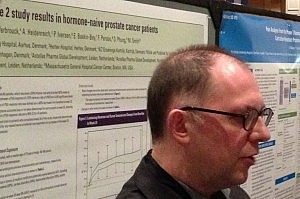 The most obvious question though, is how might enzalutamide compare with bicalutamide in the advanced prostate cancer setting? To find out about progress here, I interviewed Prof Tombal about his poster being presented at the ASCO Genitourinary meeting yesterday.
The most obvious question though, is how might enzalutamide compare with bicalutamide in the advanced prostate cancer setting? To find out about progress here, I interviewed Prof Tombal about his poster being presented at the ASCO Genitourinary meeting yesterday.
PSB: How would you describe the rationale behind your study?
Prof Tombal: The first thing that is important is what is the philosophy of the clinical trial? There has been a lot of activity in medical treatment for prostate cancer with new drugs like abiraterone, Jevtana, new chemotherapies, a vaccine, but what they all have in common that they are used in patients who are failing hormonal treatment. Today, hormonal treatment worldwide is basically medical castration, meaning that you suppress the testosterone in the whole body to get an effect on the prostate and the metastases.
The idea was to test enzalutamide, not the way it is used and prescribed now in patients who fail androgen therapy, but in patients who have never received androgen deprivation therapy. There was always the hypothesis that it might not work for unknown reasons. So we took patients who needed hormone therapy, some of them were already quite advanced, and we gave enzalutamide alone.
PSB: What kind of results did you see?
We were extremely impressed by the amplitude of response of these men. If we look at the PSA decrease, when we did that hypothesis that if 80% of the men would have a good PSA response, we would potentially have a drug with some future in that setting. But it’s not 80%, it’s much more than that. Almost all the men responded extremely profoundly to the drug with a sharp decrease in PSA, and with a toxicity that apparently is less pronounced than with androgen deprivation therapy.
The hypothesis that we might have a drug that could eventually replace androgen deprivation therapy, we now we know that the idea seems to be working and we are now saying OK, now we might have a compound simply to replace androgen deprivation therapy in all these men who need it and suffer from side effects.
Now it is creating a new paradigm because now we have to think about how we are going to develop this in the next 4 to 5 years. What is striking with the result is that actually enzalutamide is the only drug you can use as an alternative. If you think, for instance, about Zytiga/abiraterone, it needs to be used with hormone therapy, it will never replace hormone therapy. Here it is a short series (of treatment) but you have to understand we went totally blind in that patient population.
What we can say about the results is that it is far beyond any expectations we made when we planned the trial.
PSB: How would these results compare with what you would expect with bicalutamide?
Prof Tombal: In Europe, bicalutamide is registered and we still use it. If I take for instance, my personal patients, I would say 10-15% of the patients are treated with bicalutamide monotherapy.
The problem with bicalutamide is that we know that the PSA drop is never what we see with LHRH agonists; we know it is a good drug, but the trial I have indicated, that it was a chemo-equivalent only for patient with minimal disease.
Although we have no direct comparison, but we have historical comparison in Europe because we use bicalutamide a lot. If we just look at the PSA drop for instance [with enzalutamide], it is apparently much more profound than [we normally see] with bicalutamide. That is clear.
From the patients in the trial, we have observed objective tumor shrinkage, and sometimes very impressive one, something we have not seen very well with bicalutamide. We have no direct comparison, but it is clear from my perspective that it compares well with bicalutamide in terms of side effect profile because there is no castration syndrome, there is a little bit of gynecomastia, little bit of fatigue, things that are extremely well tolerated by the patient in comparison to LHRH agonists.
But the tumor response, seems – and I do insist – much better than with bicalutamide.
PSB: So will you be planning any other head to head trials with bicalutamide or the LHRH agonists?
Prof Tombal: The problem of drug development is that actually the leading dancers are the regulatory authorities. If you go to EMA, European Medicines Agency, because bicalutamide is accepted we could easily plan a trial head to head bicalutamide versus enzalutamide. The problem is that FDA never registered bicalutamide, so we have to see how they are going to behave. There are plans to conduct a trial, but the exact design of the trial, and we can’t do nothing about this, will be decided by FDA. We don’t even know right know whether it is going to be one global trial, or trial made for Europe and the US.
Interestingly also, in contrast to all the agents that have been developed in castration resistant prostate cancer, nobody has ever gone to FDA with a modern plan saying these are the problems, these are the compounds. We don’t know how they will react.
Clearly if I had all the money and all the patients, the ideal trial would be a three arm trial comparing standard hormonal treatment to enzalutamide to bicalutamide. Because, if we do that then we could really have the answer both in term of survival and in term of quality of life.
I am a urologist by training, so most of the patients I see, I would say even 85%, they won’t die from the disease. Those who have aggressive disease are seen mostly by medical oncologists. The medical oncologist concern is primarily to increase overall survival. Where my concern as a urologist is to get a similar overall survival, to keep the good result we have right now, but lower the toxicity. If I want to answer both questions at the same time, the ideal would be a three arm trial to get all the information on the quality of life and overall survival.
PSB: I think the three arm trial would be most optimal and give the definitive answer
Prof Tombal: That would be the more elegant and would be the one that would be the most scientifically satisfying.
PSB: Are there any other combination trials with enzalutamide in that setting that have piqued your interest?
Prof Tombal: If you give me $1 million dollars and ask we what is the best combination, I would say it is enzalutamide and radium-223. Because, we know something in prostate cancer, it is that there is something magical that is happening when you combine radiation therapy and hormonal treatment. That is where androgen deprivation therapy has been shown to increase overall survival. All the trials done by SWOG, EORTC and early work back in the 70’s showing that if you hit the cell with some form of DNA breaking mechanism like radiotherapy plus hormone therapy you have got something magical.
To me, the association of a very effective anti-androgen and radiation therapy is something I want to see. One of the advantage on top of that is that these two drugs do not require corticoids and are extremely well tolerated. So this is really an association i don’t fear. Radium-223 is well tolerated. In all these men we identify now with oligo-metastatic disease, combining these two drugs, give me the drug, give me the money, I would be extremely interested.
PSB: Is that trial planned at all?
Prof Tombal: I think both Bayer and Medivation are speaking to each other, so I am quite sure it is going to be planned sometime.
Additional notes…
Although I spoke to Prof Tombal prior to the meeting, I was quite unprepared for the sheer impressiveness of the waterfall plot, which showed a PSA response (i.e. a reduction > 80%) at 25 weeks of 92.5% with a fairly narrow CI (86.2-98.8%).
In a previous interview, Charles Sawyers, the co-inventor of enzalutamide discussed its potential development, including the translational opportunities beyond CRPC in earlier disease.
It looks likely, with these latest results, that enzalutamide has clear activity in advanced (hormonally-sensitive) prostate cancer and a three arm trial, as suggested by Prof Tombal, would actually answer the key question of which therapy would be the optimal solution in this setting. Hopefully, we will see more advances in this area emerge over the next couple of years. If successful, this would be a large potential market opportunity for enzalutamide, potentially much bigger than the CRPC setting before or after chemotherapy.
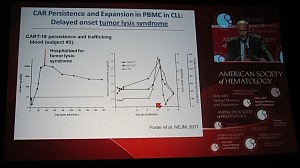
 The most obvious question though, is how might enzalutamide compare with bicalutamide in the advanced prostate cancer setting? To find out about progress here, I interviewed Prof Tombal about his poster being presented at the
The most obvious question though, is how might enzalutamide compare with bicalutamide in the advanced prostate cancer setting? To find out about progress here, I interviewed Prof Tombal about his poster being presented at the 
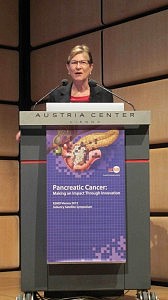 One of the most interesting highlights of this ESMO for me has actually not been some new data or science that was presented here, but the sense of anticipation about the forthcoming nab-paclitaxel (Abraxane) data in pancreatic cancer.
One of the most interesting highlights of this ESMO for me has actually not been some new data or science that was presented here, but the sense of anticipation about the forthcoming nab-paclitaxel (Abraxane) data in pancreatic cancer.
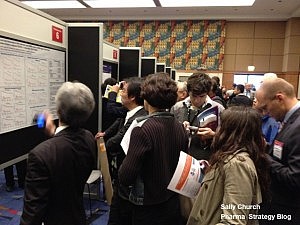 Following on from my preview of the
Following on from my preview of the  This week I’m attending an interesting 2-day conference on PI3K at the New York Academy of Sciences (NYAS).
This week I’m attending an interesting 2-day conference on PI3K at the New York Academy of Sciences (NYAS).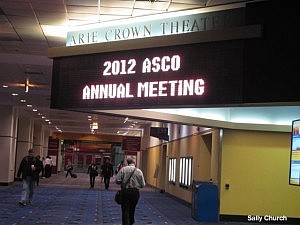 It’s been a crazy busy time since the
It’s been a crazy busy time since the 